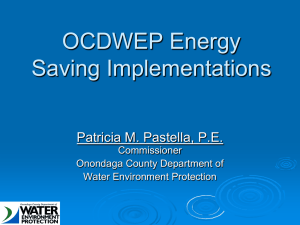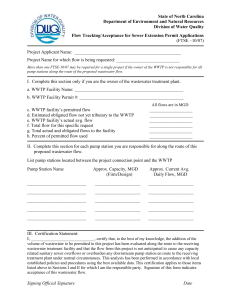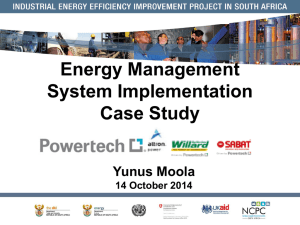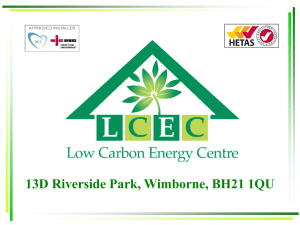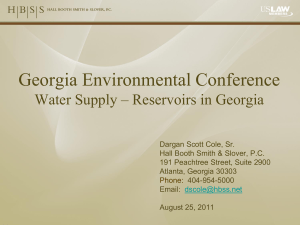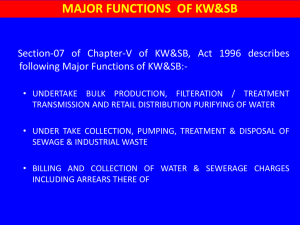Present Scenario
advertisement
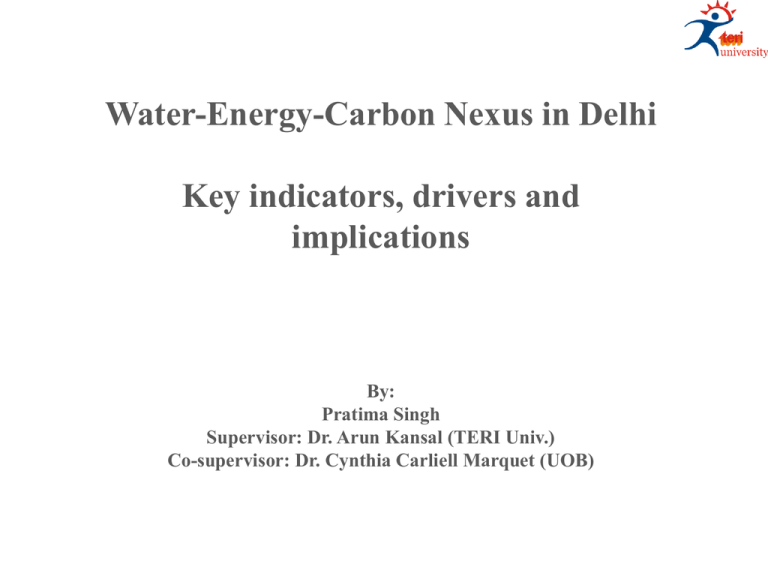
Water-Energy-Carbon Nexus in Delhi Key indicators, drivers and implications By: Pratima Singh Supervisor: Dr. Arun Kansal (TERI Univ.) Co-supervisor: Dr. Cynthia Carliell Marquet (UOB) Water-energy-carbon nexus and under rated issues ENERGY FOR WATER US- 4% for WT,5% GHG emission from water sector (1) (no embodied energy) S.A (eThekwini)- water distribution0.10 kWh/m3 , GHG emission 0.139 kg CO2e/m3 (2) Belgium- WWTP’s (0.05 to 1.34) MGD was (0.19 to 0.31)kWh/m3 (3) NW Spain- Aeration (0.177 to 0.70) MGD was (1.13 to 2.07) kWh/m3 (4) Toronto- WT 0.68 kWh/m3 and GHG 0.11 kg CO2e/m3 yr.(5) UK- 3% for WS 41 million tonnes CO2e/yr (6) (no embodied energy) Sources: 1. Rothausen.S; Conway.D, 2011 2. Friedrich et al. 2007 3. Lassaux et al., 2007 4. Gallego et L., 2008 5. Racoviceanu et al.,2007 6. Rothausen.S; Conway.D, 2011 7. World energy council report, 2010 WATER FOR ENERGY (7) Coal production- 0.164 m3/GJ Crude oil- 1.058 m3/GJ Natural gas- 0.109 m3/GJ Hydropower- 5.4 m3/MWh Solar heating- 0.954 m3/MWh Nuclear plant- 2.726 m3/MWh Solar thermal power plant- 4 m3/MWh Thermoelectric power plant3.7 m3/MWh 2 Knowledge Gaps • Lack of energy studies for urban water sector in Asia & MiddleEast. (More focus on agriculture, industries and infrastructure) • Only electrical energy consumption has been considered for the energy use in almost all the studies. • Lack of information related to emission from wastewater system including various treatment processes. • Lack of water-energy-carbon nexus study in South-Asian nation on water system 3 Aim & Objective The study aims to look into the water-energy nexus in a integrated manner for the entire urban water cycle. The nexus will focus on the criticality of one influencing the other. Total energy and forms of energy used in various aspect of urban water sector will be assimilated and also water used for energy generation will be accounted. The study will also look into the energy nexus to find its influence on the climate action plan of the city. 4 Objectives • To find the energy intensity, various form’s of energy consumption of urban water system- the factors that influence the energy use • To find how different forms has influenced overall energy consumption and climate. • To find water requirement of energy generation • Comparative analysis of Birmingham and India water system– lesson’s 5 Scope • System boundary commences at the point of raw water abstraction and ends with discharge of treated wastewater. • Various forms of energy used for operation & maintenance will be accounted (Electrical, manual, petroleum). Energy for construction, embodied energy and chemical energy are not considered. • Carbon emission (off-site and on-site) and potential fugitive emission during treatment process will be taken into account. • Impacts associated with carbon emission’s are not considered. • The end use of water is not taken into account. 6 Key research questions • What is the energy share of water sector to the city’s total energy demand ? • What is energy elasticity with respect to scale of treatment units and technology ? • Does other forms of energy has any significance in total energy estimate ? 7 Main activities of proposed research Growing and producing bio-fuels Extraction & refining Hydro power plants Thermal power plants Water for energy Fuel production Abstraction Disposal Energy for water Groundwater Surface water Intermediate pumping Off-site emissions Intermediate pumping On-site emissions Treatment WW Treatment Energy intensity (elect., manual, petroleum) On-site & fugitive emissions WW collection Wastewater pumping Off-site emissions Energy intensity (elect., manual, petroleum) On-site emissions Distribution Water pumping Tanker-fuel Domestic Booster pump Domestic purifiers Off-site emissions 8 Case study - Delhi 9 Preliminary results-LU/LC 2006 1977 NOIDA <delhi-masterplan.com> 10 (Sharma et al. 2008) (Sharma et al. 2011) Population growth in NCR Data Sources: <indiastat.com>, Census of India; Data Sources: <http://urbanindia.nic.in/theministry/subordinateoff/tcpo/DMA_Report/CHAPTER_3.pdf> 11 Population and resource migrationYamuna River basin Yamuna Yamuna basin Resource migration Population migration 12 Photo courtesy: Central Pollution Control Board, <www.google.com> Existing water sources in Delhi Water resources Delhi Total amount (MGD) Yamuna Water 339 MGD Ganga Water 240 MGD Bhakra Beas Management Board water Ground water 150 MGD 100 MGD Data Sources: MPD-2021, 2003. Department of Environment and Forest, 2010 Sources of raw water, Delhi Tehri Dam/Upper Ganga Canal, 226 km, 240 MGD Bhakra-Nangal storage/Sutlej river, 230 km, 140 MGD Western Yamuna Canal, 113 km, 100MGD Hathnikund barrage Eastern Yamuna Canal, 25 km, 240 MGD Wazirabad waterworks, 3 km Wazirabad barrage (210 MGD) Bawana waterworks Chandrawal waterworks, 3 km Sonia vihar 20 km waterworks Bhagirathi 25 km waterworks Nangloi waterworks 228km Dwarka waterworks Haiderpur waterworks I 231km Haiderpur waterworks II 112.4 km Najafgarh drain Hindon Cut Shahdara Drain Agra Canal Supplementary drain Data Sources: DHI, 2010; http://www.urbanindia.nic.in/programme/uwss/uiww/PPT _4th_Meeting/DJB_Water_PPT.pdf Okhla 14 Thermal Power Plant MPD-2021, 2003 MPD-2021, 2003 15 Declining trend in groundwater, NCR 16 Data Sources: Shekhar et al.2009 CGWB; NCRPB Energy consumption for groundwater extraction Ground water Units Avg. daily withdrawal (m3/d) Avg. Depth (m) Energy estimated (kWh/d) Delhi Private DJB Gurgaon Borewell and Tubewell Noida Borewell and Tubewell 17 Energy demand forecast for groundwater pumping Year Estimated depth (m) Estimated abstraction (m3/d) Estimated Energy consumed (MWh/d) Indirect GHG emission (Gg-CO2-e/d) 2001 2011 2021 18 Public water supplies WTPs Photo courtesy: www.stupco.com Name Capacity (MGD) Estimated Energy consumption (MWh/d) Wazirabad (I, II & III) 120 Hayderpur 200 Sonia Vihar 140 Bhagirathi (North Shahdara) 100 Nangloi 40 Chandrawal (I & II) 90 Bawana 20 TOTAL 710 19 Data Source: DJB Trend of increasing gap between water treatment and water demand 20 Data sources: Department of environment and Forest, 2010 Private water purifiers 2000s 1990s 1980s Reverse osmosis Filter + U.V. Filter 21 Photo courtesy: www.google.com Water consumption through purifiers Categories Filter Filter + UV R.O (domestic + water markets) Nothing HIG 2% 40% 43% 15% MIG 4% 48% 31% 17% LIG 13% 37% 12% 38% Daily production for water for cooking and drinking is found to be 40 liters/day per household Purifiers Filter + UV Estimated energy consumption (MWh/d) 2.74 R.O 122.35 TOTAL 125.09 22 Data Source for energy consumption of RO & Filter + UV system: Uniphil Electronics Private Limited Water distribution 23 Water distribution by tankers Zones Summer months Rest of the year No. of tankers used per week Avg. capacity of the tankers (gallons) No. of tankers used per week Avg. capacity of the tankers (gallons) Central NA NA NA NA City & Sp 120 4500 120 4500 Civil lines 3620 trips 3000-10000 lit. 1045 6000-10000 lit Karol Bagh 1000 trips 850 350 850 Mehrauli 91 1500 42 1500 Najafgarh NA NA NA NA Rohini 1791 1350 714 1350 RWS-N 721 8667 221 2657 Shah/N 2100 5000 1000 5000 Shah/S 1700 1000 1150 1000 South 1365 trips 1320 450 1320 West 860 6000 660 6000 24 Data Source: TERI Report No. 1999EE44 Photo’s courtesy: www.google.co.in/images 5741 Gallons of water is distributed everyday by private tankers. On an avg. 1910 private and 400a public tankers distribute water all over Delhi. Individual tankers travels 18 km on an avg. and makes 4 trips per day. Tankers use diesel as fuel and they still run on old engine technology. 25 a- www.ccsindia.org Area without sewerage facility Status-categories No. of colonies/villages Unauthorized colonies 1639 JJ clusters 1080 Rural villages 201 26 Data source: DJB, 2010 Gap between sewage generated and treated Wastewater scenario 700 640 600 513 500 400 MGD 360 300 MGD 200 100 0 WW generated WWTP installed capacity WW treated 27 Data source: DJB, 2010 Methodology • Literature Review • Data collected a) field observations, primary data collection b) interactions with plant operators and c) One-on-one interviews d) time inventory of various activities on field for manual energy using stopwatch. e) comprehensive inventorization of activities and their subactivities in STP demanding energy (manual, fuel, electrical) f) Validation of data with log-book and records of operation in plant g) Equal representation of weekdays and weekends was considered for monitoring 28 Methodology Estimation of electrical energy input • The electrical energy input is estimated by considering the electrical load of the pump/motor (kW), time in hours (h) for which the motor is operated and total amount of wastewater treated. • Where, Ep is the electrical energy kWh/m3; is determined using Q is the total flow of wastewater in m3/d P is the rated power of the electrical motor in kilo Watt (kW) T is the operation hours in a day (h/d) The motor efficiency is assumed as 80% (Fadare DA 2010). 29 Estimation of manual energy input • Where, Em is manual energy in kWh/m3 is determined using n is the number of nature of activities (light, active, and heavy) m is the number of gender (male, female) E is the human energy equivalent (kW) N is the number of persons engaged in an activity T is the total time devoted in the activity (h/d) Human power equivalent (E) in kW Input Male Female Activities in the treatment plant Light 0.13 0.10 Switch on/off the raw water pump, maintain the log-book, check motor temperature Moderate 0.14 0.11 Open/close the sludge drain valve, operation of valves for backwashing Heavy 0.54 0.44 Prepare the chemical solution for dosing, fill the chemical solution in the dosing tank, 30 collect the dried sludge in gunny bags Estimation of fuel energy use • Fuel energy (Ef) kWh/m3 is calculated using eq. • Where, 15.64 is the unit energy value of diesel in kWh/l (Devi 2007a) D is the amount of diesel consumed in l/d. • Diesel consumption is also used for oiling and repairing of machineries Estimation of energy use(booster pumps) for domestic purpose Interview based survey with the help of questionnaire having close ended and quantity based questions. Pilot study will be conducted 31 Estimation of GHG emission’s • Calculation of direct and in-direct emissions associated with electricity generation PCO2, electricity = Erequired ×∑ (Fi × EFi) • Where, PCO2, electricity is GHG production of the plant (kg CO2e/m3) Erequired is the electricity demands of the plant in kWh/m3 Fi is the % contribution of the fuel (i) to satisfy electricity generation needs EFi is the GHG emission factor of fuel (i) in producing electricity in kg CO2e/kWh 32 Process wise energy distribution % share to different process Aer+Bio filt 3.2% ASP 32.99% Phy-chem+bio-fil 31.71% Ext-Aer 32.1% 33 Total electrical energy consumption by centralized WWTPs 0.5 0.45 0.4 0.35 0.3 0.25 Electrical energy kWh/m3 0.2 0.15 0.1 0.05 0 45 40 40 40 37 30 25 20 20 20 16 12 10 10 10 10 10 5 3 2.2 2.2 2.2 34 Total fuel energy consumption by centralized WWTPs Total fuel energy consumption 6.00E-02 5.00E-02 Energy kWh/m3 4.00E-02 3.00E-02 2.00E-02 1.00E-02 Series1, 1.71E-04 0.00E+00 35 Total manual energy consumption by centralized WWTPs Manual energy kWh/m3 0.002 0.0018 0.0016 0.0014 0.0012 0.001 0.0008 0.0006 Manual energy kWh/m3 0.0004 0.0002 0 36 Total energy consumption by centralized WWTPs Total energy consumption 5.00E-01 4.50E-01 4.00E-01 Energy kWh/m3 3.50E-01 3.00E-01 2.50E-01 2.00E-01 1.50E-01 1.00E-01 Series1, 8.53E-02 5.00E-02 0.00E+00 37 Percentage share of energy Manual 0% Fuel 5% % of Energy forms Electricity 95% 38 Technology wise energy distribution DAF unit Polishing 0.56% unit Densadeg unit H2S 0.025% scrubber 0.86% Pump 0.06% Flash house mixer 2.74% 0.75% Plant + Admin 3.94% Screening 0.46% Grit removal 9.3% Centrifuge unit 0.06% Sludge bed filtrate 0.26% Primary Settling tank 0.59% Raw sludge pump house 0.71% Pressdeg unit 0.75% BIOFOR unit 18% Return sludge pump house 9.78% Gas holder 0.19% Digester 1.90% Aeration 48% Final settling tank 1.06% 39 Zonal energy distribution Total electrical energy kWh/m3 2.00 1.80 Zone Popl.(mill) Shahdara 1.1 1.20 Rithala 0.94 1.00 Okhla 2.86 Keshopur 2.29 CP 0.46 Outer Delhi 0.15 TOTAL 7.71 1.60 1.40 0.80 0.60 Total electrical energy kWh/m3 0.40 0.20 0.00 40 Zonal % energy distribution (SPS+WWTP’s) Coronation pillar 3% Keshopur 4% Outer Delhi 7% Shahadra 13% Rohini-Rithala 5% Okhla 67% 41 Decentralized WWTP WWTP Size of the Plant (m3/d) Energy Consumption (MWh/d) TERI WWTP 25 0.048 SMB School WWTP 50 0.25 IOCL WWTP 100 0.18 Delhi Haat WWTP 175 0.19 Escorts Hospital WWTP Fortis Hospital WWTP Apollo Hospital WWTP 300 0.36 300 0.38 1000 1.03 42 Total energy consumption and CO2 emission in urban water cycle Estimated energy consumed (MWh/d) Abstraction Water treatment Distribution WWT Indirect GHG emission (Gg CO2e/d) Ground water pumping only excluding surface water conveyance from distance Domestic/private Water Purifiers Public Tankers Pipeline (water supply + sewage) Centralized TOTAL 43 Water for energy Name Indraprastha power station Rajghat power house Fuel used Capacity Water requirement (MGD) Coal based 247.5 MW 8.6 Coal based 135 MW 4.7 GTPS Gas based 282 MW 4.2 Pragati power station Gas based 330 MW 4.9 Badarpur TPP Coal Based 705 MW 24.6 TOTAL 1699.5 MW Govt. of NCT of Delhi 2001-02 44 Water for energy Data Source: http://www.thehindu.com/todays-paper/tp-national/tpnewdelhi/article2519668.ece http://www.thehindu.com/news/cities/Delhi/article2525061.ece 45 Key indicators, drivers and Implications • Tension between water and energy is growing. Demand of energy for wastewater treatment WWTP’s in urban water cycle is increasing with increasing population, which is found to be 2.65Wh/m3 (3.9% of the total power demand of the city) and availability of water for energy generation is reducing resulting in less power generation during peak season. • Increasing trends of energy demand for sewage pumping: In Delhi from all the 7 zones the total energy use for sewage pumping is found to be about 0.13kWh/m3 , (3.5% of the total power demand of the city) • Process having the greatest impact on energy consumption: Aeration in activated sludge process that the highest energy use of 1.28kWh/m3 (48% of the total energy consumed in the treatment process). 46 Key indicators, drivers and Implications • Activated sludge process dominated the energy consumption with 0.87kWh/m3 (33% of the total energy consumed in the treatment process) compared to other technologies • Increase in energy consumption with large urban spread: Out of the seven zonal areas in Delhi, it was found that Okhla zone consumed the highest amount of energy for sewage pumping and wastewater treatment, 1.86kWh/m3 (67% of the total energy consumed in treatment and pumping process). 47 THANKS 48
